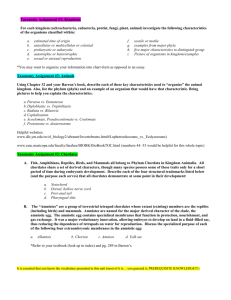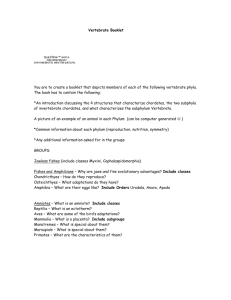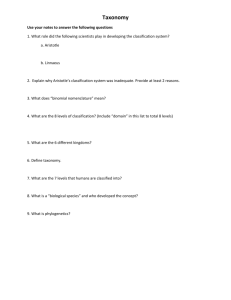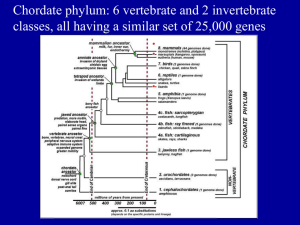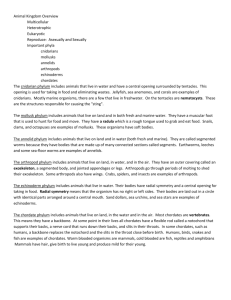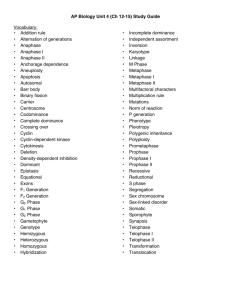Mitosis Review
advertisement
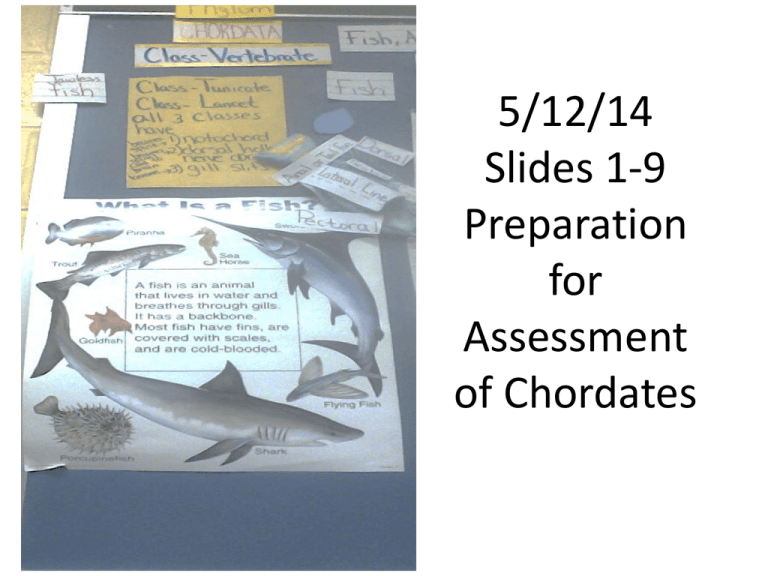
5/12/14 Slides 1-9 Preparation for Assessment of Chordates Kingdom Animal Phylum Chordata have backbone, spine, notochord Fish Jawless to Jaws Major evolution backbone and gills anatomy and function fins dorsal anal pectoral lateral line Still live in water Kingdom Animal Phylum Amphibians Kingdom Animal Phylum Reptile Kingdom Animal Phylum Aves (birds) Trends in Chordate Evolution 5:16 minutes • What are 4 characteristics of ALL chordates including humans? • Trends in chordate evolution • What are 2 characteristics SOME chordates have and others chordates do not have? • HW Answer questions and study for assessment on chordate phylum A look at future Human Evolution A look at future Human evolution Why might human evolution have slowed down? What are 3 ways humans have already evolved other than amount of hair? Text from Movie A look at future Human Evolution • • Published on Aug 6, 2013 The future of human beings Homo sapiens, the name for you, myself and ever human being that exists on our planet, we evolved from Africa about 200,000 years ago and carried on evolving until we became what we are today.but are we still evolving? Well the earth is predicted to be around about 4.55 billion years old. So in the grand scale of things our species is still very young. other humanlike creatures where around long before us, the oldest humanoid fossil was dated back to 4.4 million years ago. But because we as a race have developed this modern world of technology ultimately to make our lives easier,has this stopped us from evolving further? Evolution is when genetic changes or adaptions occur when genes mutate and combine in different ways during reproduction. This is normally to help the species survive or reproduce more effectively and happens more frequently in a population. When these changes occur they become more common across the population giving an advantage to survive. So if the purpose of evolution to to survive and reproduce, do we need to evolve any more? Are we above natural selection? Well Human beings still have many reasons to evolve, some of these might be the abilities to be immune to certain modern viruses or the abilities to be immune to high cholesterol or heart disease. Our lives are constantly changing and our body's will adapt to some of these changes. One great example of modern evolution is the ability to digest Dairy. Originally humans could only digest there mothers milk due to a gene that would eventually shut down when the child was weaned off the milk. But when we started to domesticate animals such as cows, humans evolved to have tolerance for lactose. This is thought to of happened due to the nutrients that milk would carry giving those humans a natural advantage to survive. It is thought that this ability was still developing as early as 3000 years ago. So we are still evolving and scientists think we are doing it faster than ever before. In the last 10,000 years the pace of evolution has sped up 100 times. So what does this mean for the human race? Well other than drinking milk and resisting diseases better, scientists think we are also losing our wisdom teeth and surprising that our brains are getting smaller. The average volume of the human brain has decreased from 1500 cubic centimetres to 1,350 cubic centimetres in the last 30,000 years. Scientists are not sure why are brains are getting smaller although there are some theory's of it being more efficient as we evolve. But what will we look like in the future? Well let's start at the bottom.we have evolved over the years to have become less reliant on the need to climb and have favoured the ability to walk. So nature has been slowly shrinking our toes to the point where we can hardly hold a pen between them let alone a branch. Some Scientists believe that in the future we will not have our little toes as we only need to rely on out big toes for balance. Another theory is that we will be much taller. Over the last two centuries the average height of humans has increased by 10 centre meters. This is due to better nutrition available to us and being able to eat regularly. But just because we could be taller doesn't mean that we will be stronger. Due to the increasing reliance on technology our muscles don't need to be as strong as they did. So the more our machines work for use the less we need to do resulting in a weaker race of humans. Over thousands of years humans have been slowly losing there hair. There are a number of different causes for this but one main reason is that human men are attracted to less hairy women. Meaning that women's body's could be a lot bolder in the future. Also the fact that we tend to wear clothes to keep us warm now has meant that there is no need for a big fluffy fur coat. But I think the strangest of all the changes that might happen to our bodies is our face. Scientists predict that in a few million years humans may have flat faces, big round eye and small noses. But by the time all of these changes have occurred, the future homo sapiens will look back at there ancestors and think we were the weird looking humans just like we do to our ancestors. So I think one thing that we all must remember from time to time is that we might be able fly thousands miles in a plane or perform extremely complicated operations. But at the end of the day Mother Nature is still looking out us. Mother Nature still has a part to play. I hope you enjoyed this video and make sure you checkout some of my other stuff. Leave a comment if you have any ideas about what we will eventually evolve in to or if you just want to discuss this subject. Thanks for watching and il see you next time. Music by -Kevin McLeod - brittle rille Trace the Evolution of Shape in the Animal Kingdom 5/19 Cool Science While Students are arriving Video 44.54 minutes 1 a day…today is the Hammer Head Shark Day 1 1. What theory is used to explain the Hammer Head Shark’s Shape? 2. What was used as the control group in the experiment used to test the purpose of Hammer Head Shark’s head shape? Future to 5/12/14 work started on 5/19 • 5/19 MAPS testing • Review prior questions slides 7-9 Meiosis used to make 4 genetically different cells beads to show mitosis and meiosis Prophase I crossing over occurs to give variability Metaphase I Independent Assortment Anaphase I Telophase I Cytokinesis results in 2 cells Skip Interphase Metaphase II Anaphase II Telophase II Cytokinesis results in 4 cells either 4 sperms or 1 egg and 3 polar bodies Mitosis used to make 2 identical cells and repeats continuously diploid allele haploid prophase centromere gene chromosome anaphase interphase nucleus homologous telophase metaphase Mammal respiration • Read the respiratory system of mammals in life science
